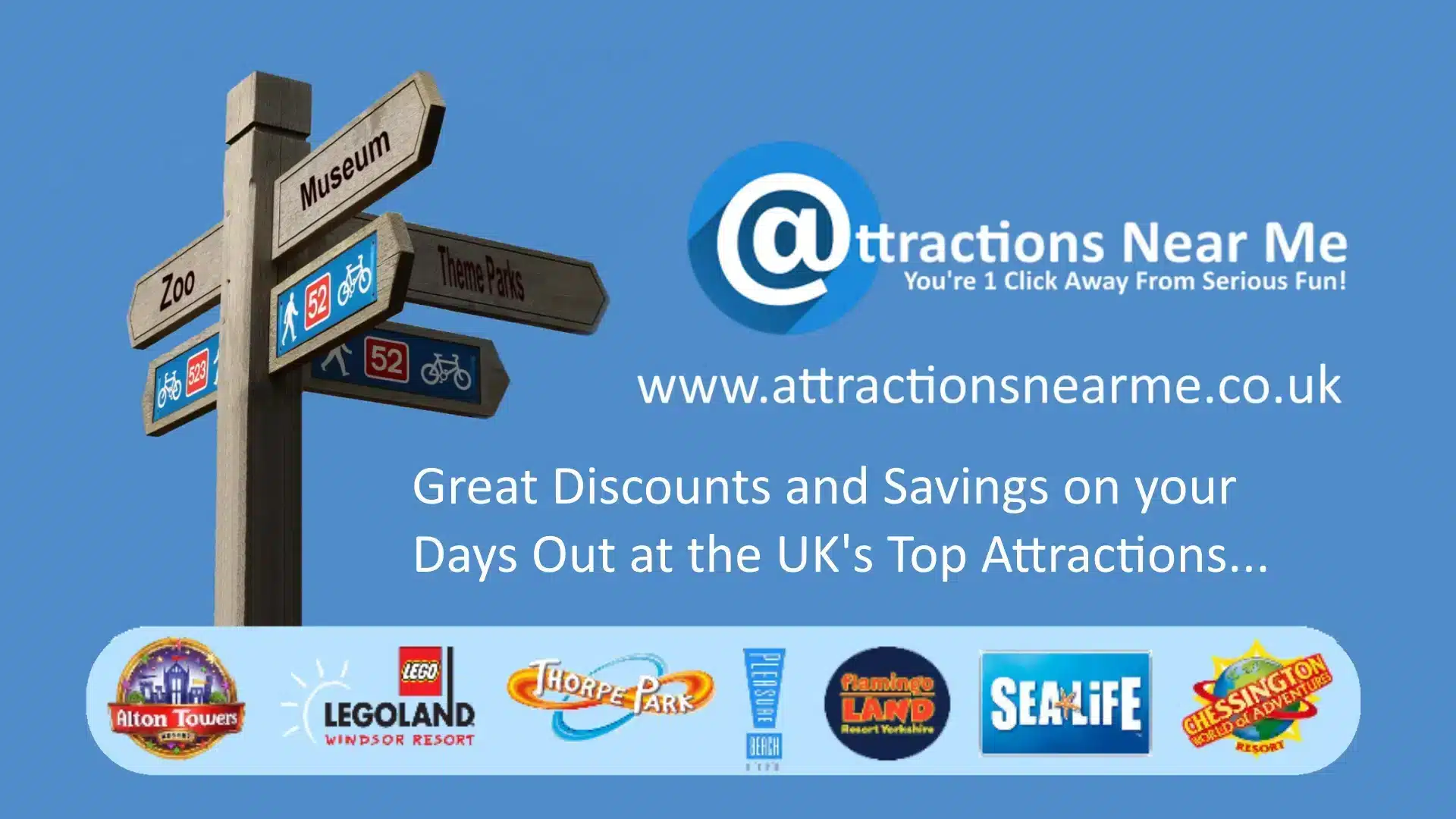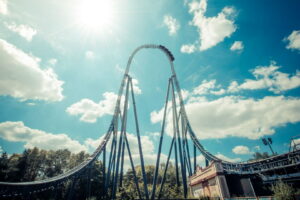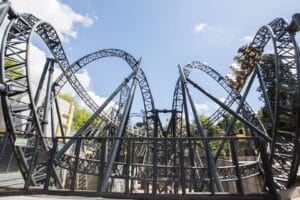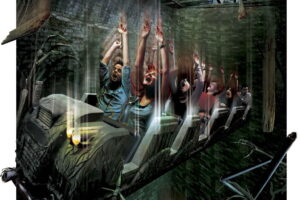Currently, there are three major types of roller coasters, distinguished mainly by their track structure, wooden, steel and hybrid. There are lots of examples of both wooden and steel rollercoasters in the UK but no hybrids at the time of writing.
The different Types of Roller Coasters
For many years, all roller coasters were constructed using large wooden structures, typically arranged in a lattice and painted white. Their tracks were generally made of wooden stacks topped with a thin and narrow strip of metal along which trains outfitted with steel wheels would roll. Blackpool Pleasure Beach features some great examples of classic wooden roller coasters. Wooden roller coasters rattle around as they roll over the joints that connect the pieces of the wooden track.
In 1959, there was a major breakthrough, when Disneyland Park in California, in conjunction with ride manufacturer Arrow Dynamics, introduced Matterhorn Bobsleds, the world’s first tubular steel coaster. The Matterhorn Bobsleds revolutionised the roller coaster industry utilising a steel structure, tubular steel track and trains with polyurethane wheels. The steel manufacturing process allows for smooth curved sections of track that tilt the roller coaster train in all directions. The tubular steel track is prefabricated in large segments and the track pieces are welded together with precision, making for an incredibly smooth ride.
In 2011, Six Flags Over Texas and Rocky Mountain Construction rolled out the New Texas Giant. This was another revolution in the industry creating a third category, the hybrid wooden and steel coaster.
Wooden Roller Coasters
All elements of the original and classic wooden roller coasters are constructed from timber. The tracks on a wooden roller coaster are similar to traditional railroad tracks. In the majority of cases, the roller coaster train wheels have the same flanged design as the wheels of a railroad train. The inner part of the wheel has a wide lip that prevents the roller coaster train from rolling off the side of the track. The roller coaster train also has another set of wheels (or occasionally, a safety bar) that runs underneath the track to prevent the train from flying up into the air.
Wooden coaster tracks are braced by wooden cross ties and diagonal support beams. The entire track structure rests on an intricate lattice of wooden or steel beams, just like the beam framework that supports a house or skyscraper. Track designers can even flip the train upside down (though this is rare in modern wooden coasters). But, because the track and support structure is so cumbersome, it is difficult to construct complex twists and turns. In wooden coasters, the exhilarating motion is mainly up and down.
Even though wood has its limits, which typically make wooden coasters slower and tamer than steel coasters, it also has advantages. Wooden coasters are designed to sway slightly as the train moves through them, which lends a unique effect that cannot be replicated with more rigid materials.
Steel Roller Coasters
The range of motion is greatly expanded in steel roller coasters. The world of roller coasters changed radically with the introduction of tubular steel tracks in the 1950s. As the name suggests, these tracks consist of a pair of long steel tubes. These tubes are supported by a sturdy, lightweight superstructure made of slightly larger steel tubes or beams.
Tubular steel roller coaster wheels are typically made from polyurethane or nylon. In addition to the traditional wheels that sit right on top of the steel track, the cars have wheels that run along the bottom of the tube and wheels that run along the sides. This design keeps the car securely anchored to the track, which is absolutely essential when the train runs through the coaster’s twists and turns.
The roller coaster trains cars on tubular steel coasters may rest on top of the track, like the wheels in a traditional wooden coaster. Alternatively, they may be attached to the track from the top of the roller coaster train. Roller Coasters attached from the top of the train are either suspended coasters, where the hanging trains swing from a pivoted joint (adding an additional side-to-side motion) or inverted coasters, where the hanging train is rigidly attached to the track, giving the designers more precise control of how the cars move.
Hybrid Roller Coasters
A recent development in the Theme Park industry is the Hybrid Rollercoaster where engineers marry a steel track to a wooden structure. According to Fred Grubb, owner of Rocky Mountain Construction (RMC), the evolution of the hybrid coaster was due more to necessity being the mother of invention rather than a grand plan. Major US Theme Parks, had called his company in to try to repair and finesse ageing, rough wooden roller coasters by partially re-tracking them. Like the local council filling potholes after the winter months, the repairs would work temporarily, but the wooden roller coasters would inevitably revert to delivering excessively rough rides. Grubb and his team figured there had to be a better way and their solution was to rip out the traditional wooden coaster track and replace it with a steel one.
Instead of a tubular steel track, the Rocky Mountain Construction team developed a patented “IBox” steel track that they also refer to as “Iron Horse” track. As its name implies, the innovative track is shaped like the letter “I.” The coaster trains’ guide wheels, which are located on the sides of the wheel assemblies, fit snugly into the channels created by the tops and bottoms of the “I.” Like a steel coaster, the trains on Rocky Mountain’s hybrid rides use polyurethane wheels. The main wheels roll along on the flat surface of the IBox track.
The combination of elements (especially the IBox track) yields deliriously smooth rides that are reminiscent of the best steel coasters, yet the hybrid coasters somehow retain their rough-and-tumble wooden coaster identity at the same time. The cars more closely resemble ones found on wooden coasters than steel ones. Thanks to the ingenious IBox track, hybrid rollercoaster can mimic steel coasters with the inclusion of inversions.
The Roller Coaster Database (rcdb)
According to the Roller Coaster Database, there were 5,036 roller coasters in operation around the world in 2019 — 4,848 of them are constructed from steel, 188 wood. The RCDB identifies eight main coaster types:
Sit-down: The traditional design, with riders sitting inside a car.
Inverted: The train travels below the track instead of on top of it. It is distinct from a suspended coaster since the train is fixed to the track.
Suspended: The train travels beneath the track, but unlike an inverted coaster, the train is fixed to a swinging arm that pivots from side to side.
Wing: Two seats from each car are positioned on either side of the track. The seats spin or rotate on their own axis, either freely or in a controlled motion. This type of coaster is sometimes referred to as 4th Dimension.
Flying: Riders start out in a seated position but are rotated to face the ground as the ride starts, giving the feeling of flying.
Stand-up: Riders stand on the train’s floor instead of sitting.
Bobsled: Wheeled trains slide down a U-shaped tube instead of being fixed to a track.
Pipeline: The track is attached to the middle of the train, instead of above or below it.
The many different Types of Roller Coasters
4th Dimension Roller coaster
Accelerator Coaster
Alpine Slide – Zip World
Bobsled roller coaster – Avalanche
Dive Coaster – Oblivion
Figure 8 roller coaster
Floorless
Flying roller coaster – Galactica
Hybrid
Hypercoaster
Impulse roller coaster
Inverted roller coaster – Nemesis
Launched roller coaster – Stealth, Rita
Mine train roller coaster
Motorbike roller coaster – Velocity
Mountain coaster
Out and back roller coaster
Pipeline roller coaster
Powered roller coaster – Buffalo Drayton Manor, Scorpion Chessington
Dual-tracked roller coaster
Terrain roller coaster
Shuttle roller coaster
Side Friction Roller coaster
Sky Rocket II
Spinning roller coaster – Spinball, Dragons Fury
Stand-up roller coaster – Shockwave
Steel roller coaster
Steeplechase – Blackpool Pleasure Beach
Suspended roller coaster
Toboggan (roller coaster)
Twister roller coaster
Virginia Reel roller coaster
Water coaster
Wild Mouse
Wing Coaster – Swarm at Thorpe Park
Wooden roller coaster










